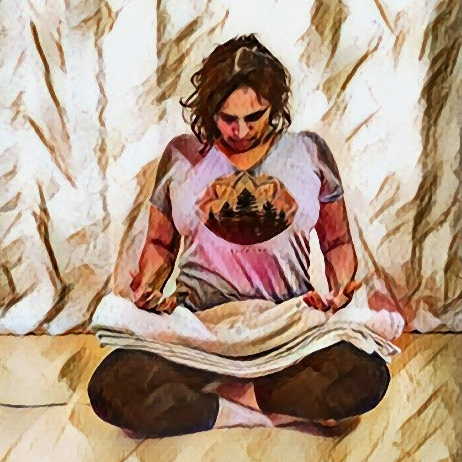Svadhyaya / self-study: 5th metatarsal fracture
At 5’3” I often need to step on stools, chairs, or other sturdy objects to reach things. Household bouldering is not outside my realm of daily activities. Step on to the stool, extend the side body and grab the jar; step onto the step ladder and even though the light bulb is just in reach I can change it; onto the bed frame to reach the curtain rod to take it down to wash the curtains. Don’t need my climbing shoes for those daily activities. Although I’m no stranger to a little climbing indoors and out. Sometimes things just happen.
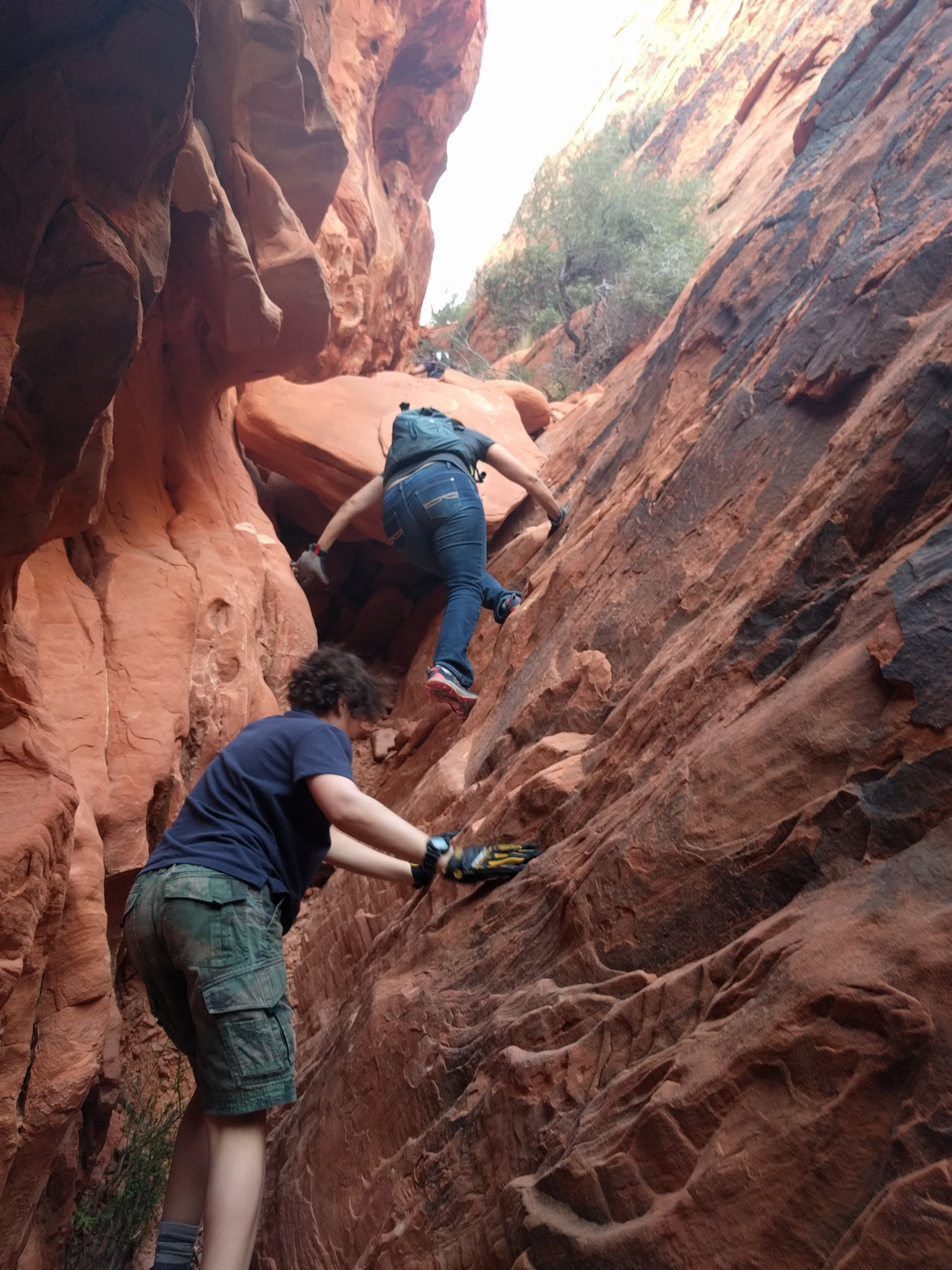
As I was getting ready to head out to teach one Monday evening. I stepped on to a new climbing object (wood storage box for Richard’s dog food) near the door to close the blinds. I stepped down, unfortunately onto a shoe standing on its side beside the box. The shoe flipped, the outer edge of my foot rolled and the box slipped forward. I landed on my buttocks and to avoid hitting my head on a wall edge I twisted and put my hand down all in a fraction of a second. I felt faint, but I knew there was no time for fainting or I’d be late for class and it was too late to get in touch with students to cancel. Knowing I now won’t make it there walking, I drove the three blocks. I taught my class brushing off the limping the students noticed as a ‘little pain from stepping off a chair onto my foot awkwardly’. After class I drove home, had dinner with my family and went to bed in hopes it would be better after a good night's rest.
The next morning it seemed to be worse not better so I decided a trip to the emergency was warranted. I used my hiking poles to redirect the pressure from my foot to my upper body and relieved some of the pain. Four hours and several hand and foot x-rays later, as the only emergency doc working that day walks by on his way to see another patient called out to me ‘hand is ok, but broken 5th metatarsal. You need a boot and I'll refer you to an orthopedic surgeon’. (bones in green)
Apparently putting on a walking boot and how to manage life in it is self-evident as I received no guidance. They did say you can weight-bear, we’ll send you the bill for the boot, have a good day. Off I went with my hiking poles and a boot that elevated my right leg about 2 inches. Walking out of the emergency to grab the uber, I thought, this isn’t going to work. I’m so grateful for my yoga practice that helped me analyze, understand and overcome various hurdles.
One day of walking in the boot and using the poles to go up and down three flights of stairs informed me that I should get crutches as the poles were not adequately stable to be able to help relieve the pressure put on the swollen fractured foot nor to stabilize my gait. At the end of the day, I could sense the unevenness in the leg length created by the boot starting to negatively affect my pelvis and my hips, knees and back. I turned to my yoga practice and found relief beyond physiology with asana and pranayama.
I researched and determined which variety of crutches would work best for my needs and ordered them. I cannot help but wonder why they were not offered to me at the hospital. Perhaps they thought it was best for the orthopedic surgeon to assess the mobility support I needed. I am thankful they were not offered as I would not have had the opportunity to research before buying. The crutches made everything so much manageable.
The Tuesday after the Monday that I broke my foot, was an online class day making transit to work up three flights of stairs. Thankfully my son arrived home before I had to go up the stairs as Richard’s vision isn’t what it used to be and most often needs help going up and down the stairs. He doesn’t like being downstairs if I’m upstairs, so I had to get him upstairs. However over the weeks, I have had to get Richard up myself. It was a bit of a process, but doable. The dog carrier I was looking at last summer would have been handy, but we learn to make do with what we have.
The hall where I teach yoga is an eight minute walk from home. Once I walked there, taught for an hour and a half and walked back and realized it was too much. It seemed silly to take an uber 4 blocks, but I’ve learned to practice santosha and accept circumstances as they are and that I needed to accept walking there or back is fine, but not both ways. Students kindly offered to drive me home and sometimes I graciously accepted. But otherwise, I’ve gotten to know the Uber drivers in our neighborhood on the way to the hall and I walk home. Initially the walk was 25 to 30 minutes. Now at week 6, it’s 9 minutes.
A week after the injury I had another x-ray and met with the orthopedic surgeon. She listened, explained and I did not feel rushed. She said I had to be in a boot for a full six weeks. Not because it takes that much time to heal, but because it takes that much time for the calcification to be visible on an x-ray. When the boot comes off, it’s another 6 weeks in a hard soled shoe.
The boot restricts movement from the mid shin to the toes, and it’s height causes uneven leg length and uneven weight distribution. These changes alter my gait and travel up my body resulting in discomfort. Without my yoga practice mitigating these effects I could continue to have discomfort after I no longer need the boot.
To offset the indirect pains to come I wear shoes with elevated heels and heel lifts that minimize the height differential. The crutches distribute the weight more evenly and decrease pressure on the injured foot.
The first time I took Richard for a walk around the block, it was quite challenging managing the leash and the crutches and I was tired at the end. I did not want to deny him his walks, so I persisted, my tapas/self discipline carried me. Initially it took 60 minutes to complete our usual 25-30 minute neighborhood walk, but by week 5 in the boot, our neighborhood walk on crutches was down to 35 minutes.
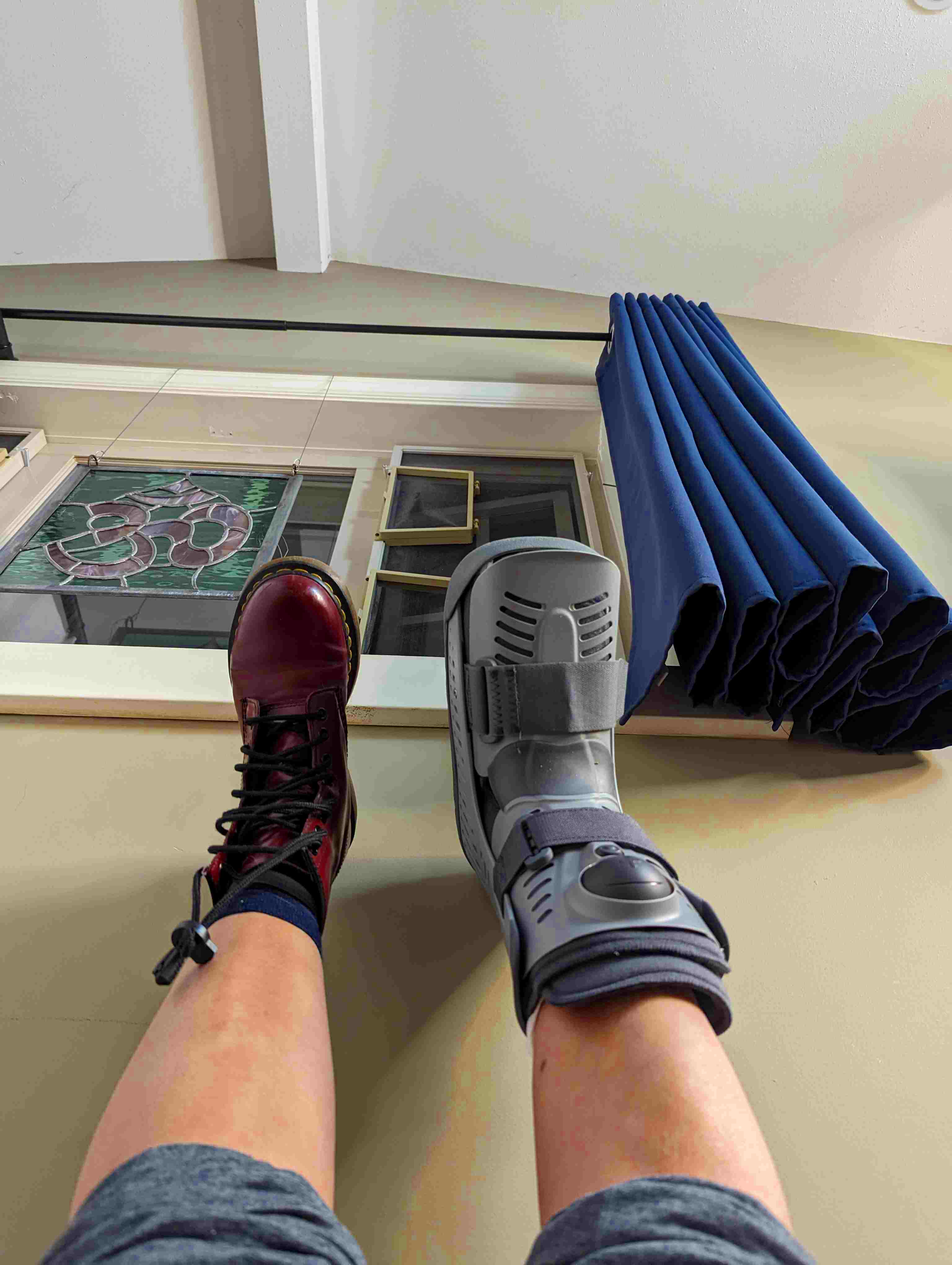
Yoga practice Svadhyaya / self study was refocused to find adaptations to be able to continue to practice.
Viparita karani was instinctively my first pose. The elevation helped relieve the pressure and swelling. The pose itself was quieting and restful.
The use of props and various adaptations of asana support my practice.

Some asana are only accessible on one side.
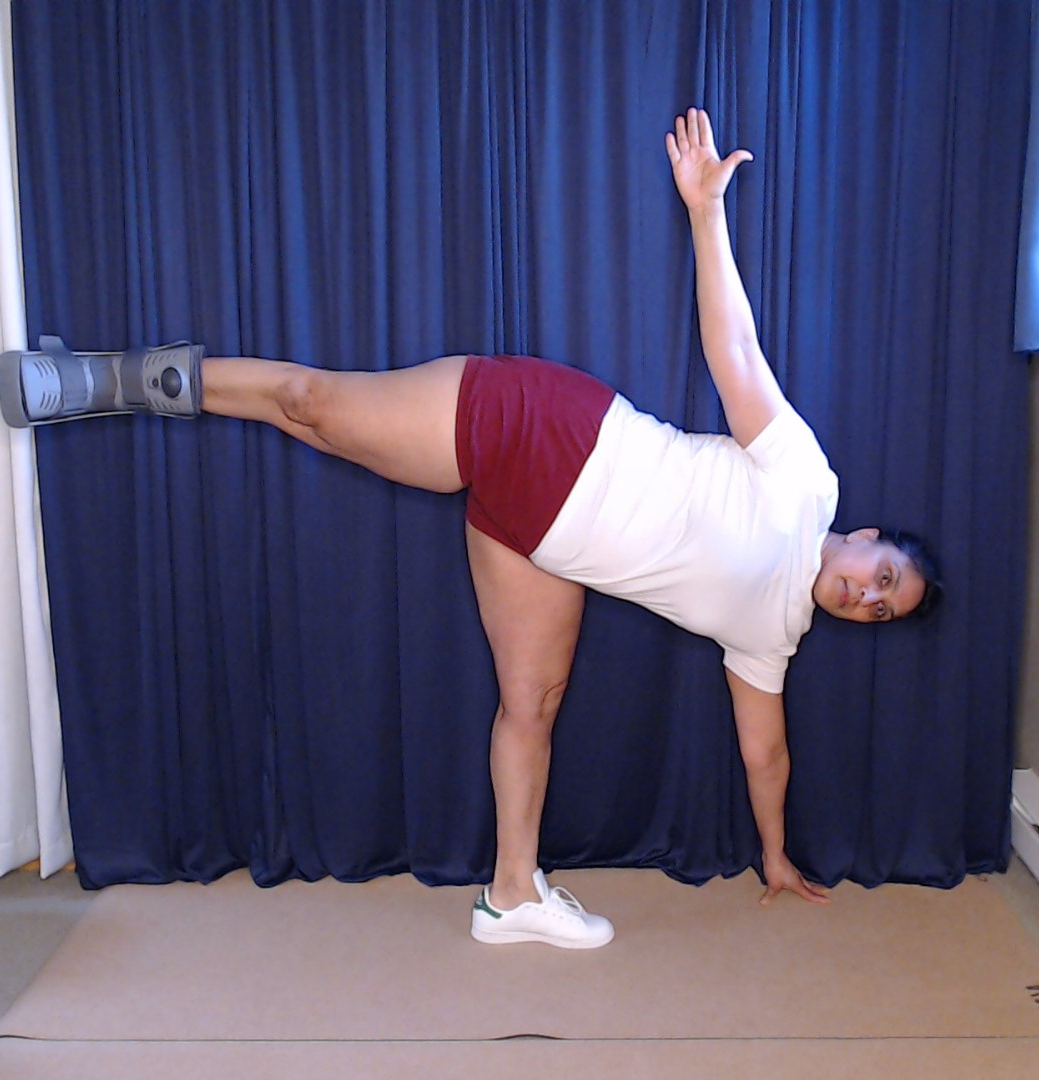
Others I support with one leg, but still activate the other. I’ll even out when I’m out of the boot.
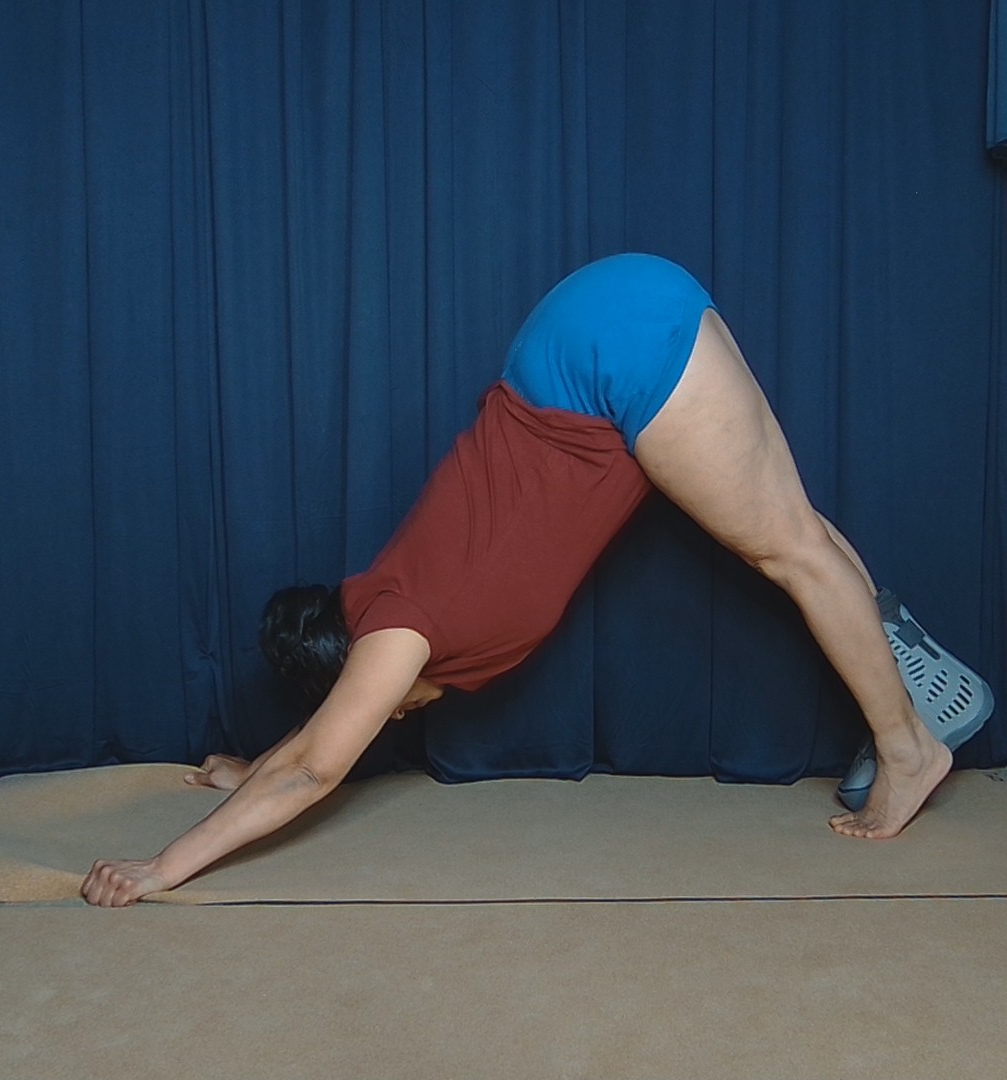
Week 3 I decided sirsasana would be possible. The ascent and descent with a bent knee keeps the boot elevated to ensure no extra pressure on the foot. Years ago practicing sirsasana with ankle weights paid forward to help lift the weighted leg. Balancing weight (of the boot) only on one leg is the challenge.
I continue to adapt as I practice and teach. In a little over a week I will complete seven weeks (the surgeon is away during week 6) in the boot at which point I hope to be bootless and feel the ground with my feet.
I am so grateful for Iyengar tradition training, my yoga practice and support of students who study with me online and in person. This injury has come with so many restrictions and obstacles. We live our lives, we encounter obstacles and we learn to overcome them.
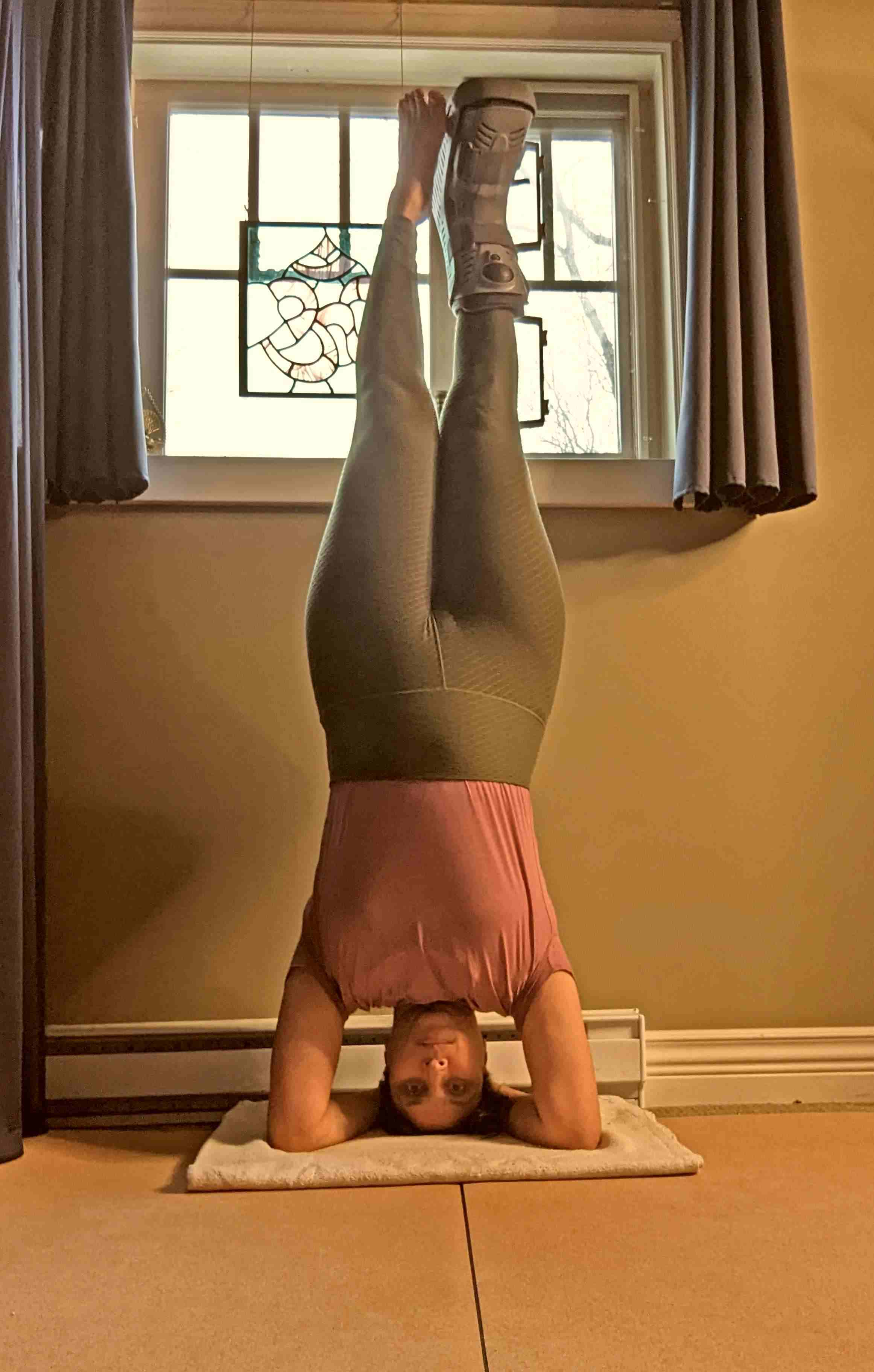
NOTE: I do not suggest that you practice yoga in these ways if you have a foot or ankle injury. You should consult a medical professional. This is my svadhyaya / self-study.

